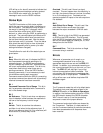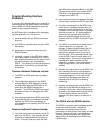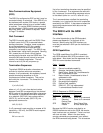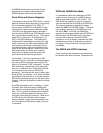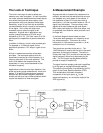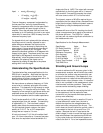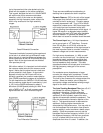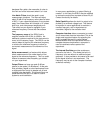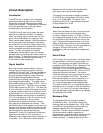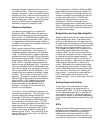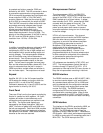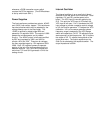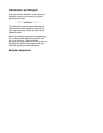27
bandpass filter adds a few nanovolts of noise to
the front end of the instrument when it is in use.
Line Notch Filters should be used in most
measurement situations. The filters will reject
about 50 dB of line frequency noise (about a factor
of 300). If your reference frequency is one octave
away, then these filters will introduce a 10° phase
shift error, and a few percent amplitude error.
Their effect on your signal is negligible if your
reference frequency is more than two octaves
away.
The frequency range of the SR510 lock-in
amplifier extends from 0.5Hz to 100KHz. No
additional cards are required for the instrument to
cover its full frequency range. The SR510 can be
used to detect a signal at the reference frequency
or at twice the reference frequency to allow for
convenient measurement of the harmonic of the
signal.
Noise measurement is a feature which allows
direct measurement of the noise density of the
signal at the reference frequency. This is a useful
feature to assess at what frequency you should
run your experiment.
Output Filters can have one pole (6 dB per
octave) or two poles (12 dB/octave). A two-pole
filter provides a signal to noise improvement over
a single-pole filter due to its steeper roll off and
reduced noise bandwidth. Single-pole filters are
preferred when the lock-in is used in a servo
system to avoid oscillation.
In many servo applications, no output filtering is
needed. In this case, the SR510 may be modified
to reduce the output time constant to about 20 µS.
Contact the factory for details.
Ratio Capability allows the lock-in's output to be
divided by an external voltage input. This feature
is important in servo applications to maintain a
constant loop gain, and in experiments to
normalize a signal to the excitation level.
Computer Interface allows a computer to control
and to record data from the instrument. This is the
single most important feature for extending the
lock-in's capabilities and it's useful lifetime.
Measurements which are impractical without a
computer become simple when a computer is
used to coordinate various parts of the
experiment.
The Internal Oscillator provides a reference
source for the lock-in. This allows the lock-in's
frequency to be set without an additional signal
generator. It also provides a sine wave to be used
as the signal stimulus in an experiment. The
frequency may be set via the computer interface
as well as manually.




